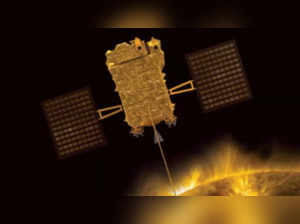India’s groundbreaking mission, aimed at studying the , is swiftly approaching its crucial moment of settling into its designated orbit, expected to occur on the evening of January 6. Launched on September 2, the is on the cusp of entering what’s termed a ‘ ‘ around the Lagrange Point 1 (L1), a unique position within the dynamic Sun-Earth system. L1 stands out among the five points in this system where the gravitational forces between the Earth and the Sun reach equilibrium, making it relatively stable and ideal for the spacecraft’s observations.
Positioned about 1. 5 million kilometers away from Earth, this location offers a strategic vantage point to observe the Sun, merely accounting for 1% of the total distance between our planet and the Sun. “Aditya L1 has already reached the , and the imminent manoeuvre on January 6 will precisely position it into the desired orbit.
Without achieving this orbit, the spacecraft would continue its trajectory towards the Sun,” affirmed an official. Crucially, entering a ‘halo ‘ around L1 presents significant challenges. Annapurni Subramaniam, director of the , explained, “Aditya L1 will transition into a halo orbit around the L1 point, synchronizing its movements with the Earth’s orbit around the Sun.
” This intricate manoeuvre involves firing thrusters to alter the spacecraft’s speed and trajectory. Dibyendu Nandi, Chair of the Aditya L1 mission’s Space Weather and Monitoring Committee, emphasized its critical nature, stating, “Missing the intended orbit in the initial attempt would necessitate multiple subsequent corrections and thruster firings. ” During its 124-day space journey, Aditya commenced scientific data collection just 16 days into its expedition, yielding insights into high-energy X-rays of flares and comprehensive solar disc imaging.
Aditya’s suite of seven scientific instruments, including the Visible Emission Line Coronograph (VELC) and Solar Ultraviolet Imaging Telescope (SUIT), is primed to track the Sun directly. Additional tools, such as the Aditya Solar Wind Particle Experiment (ASPEX) and Plasma Analyser Package for Aditya (PAPA), will facilitate on-site measurements. Crucially, Aditya’s insertion into a halo orbit around L1 will grant it unfettered access to study solar storms and emissions from the Sun before they affect Earth or fall within the Earth’s magnetic field.
The mission’s comprehensive study of solar phenomena at various wavelengths and measurement of radiation, particles, and magnetic fields is drawing global attention. Prof R Ramesh of the Indian Institute of Astrophysics highlighted, “Aditya L1 aims to examine the solar corona more closely than ever before, enabling observations with smaller occulting disks for enhanced precision. ” Scheduled for Saturday, the final manoeuvre to place Aditya-L1 into its halo orbit marks a pivotal milestone in India’s space exploration endeavors.
With its diverse payload, this mission promises groundbreaking insights into the Sun’s behavior and phenomena, complementing data from existing satellites like SOHO. Ensuring Aditya remains in its designated orbit poses ongoing challenges, demanding precise orbit determination and periodic adjustments, as emphasized by ISRO chairman S Somnath. The spacecraft’s proximity to the Sun at L1 presents both opportunities for unparalleled observation and the need for meticulous maintenance to navigate the intricacies of this unique solar observation point.
As Aditya L1 nears its momentous orbital positioning, India’s foray into solar exploration heralds a new chapter in space research, poised to unlock unprecedented insights into our nearest celestial neighbor, the Sun. (Catch all the , Events and Updates on . ).
From: economictimes_indiatimes
URL: https://economictimes.indiatimes.com/news/science/isros-aditya-l1-mission-on-the-brink-of-solar-breakthrough-entering-its-ultimate-orbit/articleshow/106557953.cms
